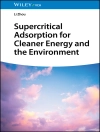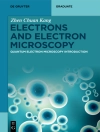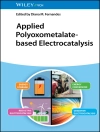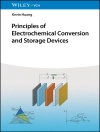Introduces basic principles and mechanisms, covers new developments, and provides a different view of the main facets of bioelectrosynthesis
Bioelectrosynthesis represents a promising approach for storing renewable energy or producing target chemicals in an energy-sustainable and low-cost way. This timely and important book systemically introduces the hot issues surrounding bioelectrosynthesis, including potential value-added products via bioelectrochemical system, reactor development of bioelectrosynthesis, and microbial biology on biofilm communities and metabolism pathways. It presents readers with unique viewpoints on basic principles and mechanisms along with new developments on reactor and microbial ecology.
Beginning with a principle and products overview of bioelectrosynthesis, Bioelectrosynthesis: Principles and Technologies for Value-Added Products goes on to offer in-depth sections on: biogas production and upgrading technology via bioelectrolysis; organic synthesis on cathodes; chemical products and nitrogen recovery; external electron transfer and electrode material promotion; and the microbiology of bioelectrosynthesis. Topics covered include: hydrogen production from waste stream with microbial electrolysis cell; microbial electrolysis cell; inorganic compound synthesis in bioelectrochemical system; microbial growth, ecological, and metabolic characteristics in bioelectrosynthesis systems; microbial metabolism kinetics and interactions in bioelectrosynthesis system; and more.
* Comprehensively covers all of the key issues of biolelectrosynthesis
* Features contributions from top experts in the field
* Examines the conversion of organic wastes to methane via electromethanogenesis; methane production at biocathodes; extracellular electron transport of electroactive biofilm; and more
Bioelectrosynthesis: Principles and Technologies for Value-Added Products will appeal to chemists, electrochemists, environmental chemists, water chemists, microbiologists, biochemists, and graduate students involved in the field.
विषयसूची
Preface xiii
Section I Principle and Products Overview of Bioelectrosynthesis 1
1 Principle and Product Overview of Bioelectrosynthesis 3
Fang Zhang, Yuquan Wei, and Guanghe Li
1.1 Introduction 3
1.2 Evolution of Bioelectrosynthesis 6
1.3 Fundamental Principles of Bioelectrosynthesis 9
1.4 Plethora of Applications for Chemical Production 11
1.4.1 Hydrogen Production 11
1.4.2 Methane Production 12
1.4.3 Alcohol Production 16
1.4.4 Short-chain Organic Acid Production 17
1.4.5 Ammonia Production and Nitrogen Recovery 23
1.5 Key Factors for Improving MES Performance 26
1.5.1 Electron Transfer from the Cathode to the Cell 26
1.5.2 Cathode Materials 27
1.6 Summary 29
References 29
Section II Biogas Production and Upgrading Technology via Bioelectrolysis 39
2 Hydrogen Production from Waste Stream with Microbial Electrolysis Cells 41
Defeng Xing, Yang Yang, Zhen Li, Han Cui, Dongmei Ma, Xiaoyu Cai, and Jiayu Gu
2.1 Construction of MEC and Scale-up 42
2.1.1 Laboratory-Scale MEC 44
2.1.2 Pilot-Scale MEC 46
2.2 Electrode Material of MEC 47
2.2.1 Anode of MEC 47
2.2.2 Cathode of MEC 49
2.2.2.1 Cathode Base Materials in MEC 49
2.2.2.2 Cathode Catalysts in MEC 49
2.2.2.3 Biological Catalysts in MEC 51
2.3 Effect of Operation Conditions on Hydrogen Production 51
2.3.1 Effect of Substrate on Hydrogen Production 51
2.3.2 Effects of Applied Voltage and Magnetic Field on Hydrogen Production 52
2.3.3 Effect of p H on Hydrogen Production 54
2.3.4 Effect of Temperature on Hydrogen Production 54
2.4 Electroactive Biofilm Microbiome and Syntrophic Interaction in MEC 54
2.4.1 Anodic EAM and Biofilm Formation 55
2.4.2 EAM in the Cathode 56
2.4.3 Microbial Community and Syntrophic Interaction 58
2.4.3.1 Pure Culture and Mixed Culture 58
2.4.3.2 Microbiome in Electroactive Biofilms 58
2.4.3.3 Suppressing the Methanogens 59
2.5 Coupled System for Biohydrogen Production 60
2.5.1 MEC–MFC-Coupled System for Biohydrogen Production 60
2.5.2 AD–MEC-Coupled System for Hydrogen Production 60
2.5.3 Solar-Powered MEC-Coupled System for Hydrogen Production 61
2.5.4 Other Modified MEC System for Hydrogen Production 61
2.6 Challenges and Outlook 62
Acknowledgment 63
References 64
3 A Promising Strategy for Renewable Energy Recovery: Conversion of Organic Wastes to Methane via Electromethanogenesis 71
Zhiqiang Zhao and Yaobin Zhang
3.1 Introduction 71
3.2 Advances in Electromethanogenesis 72
3.3 Mechanisms of Electromethanogenesis 75
3.3.1 Electron Transfer from Electrode to Methanogens 75
3.3.2 Microbial Communities of Biocathode 77
3.4 Applications of Electromethanogenesis 81
3.4.1 Renewable Energy Storage 81
3.4.2 Biogas Upgrading 82
3.4.3 Organic Waste Treatment 83
3.5 Outlook 86
References 87
4 Microbial Electrolysis Cell (MEC): An Innovative Waste to Bioenergy and Value-Added By-product Technology 95
Abudukeremu Kadier, Najeeb K. N. Al-Shorgani, Dipak A. Jadhav, Jayesh M. Sonawane, Abhilasha S.Mathuriya, Mohd S. Kalil, Hassimi A. Hasan, and Khulood Fahad Saud Alabbosh
4.1 Introduction 95
4.2 Microbial Electrolysis Cell (MEC) for Hydrogen Production and Waste Treatment 96
4.2.1 Working Principles 96
4.2.2 Advantages of MEC Over Other Potential Waste Treatment Technologies 97
4.3 Different Types of Waste Feedstocks Used in MECs 99
4.3.1 Simple or Defined Substrates 99
4.3.1.1 Glucose 106
4.3.1.2 Acetate 106
4.3.1.3 Glycerol 106
4.3.1.4 Proteins 107
4.3.1.5 Volatile Fatty Acids (VFAs) 107
4.3.1.6 DF Effluents and Other Pure Substrates 108
4.3.2 Wastewater Feedstocks 108
4.3.2.1 Domestic Wastewater (DW) 108
4.3.2.2 Industrial Wastewater 109
4.3.3 Complex or Lignocellulosic Biomass Materials 110
4.3.4 Waste-Activated Sludge (WAS) 110
4.3.5 Agricultural Wastes and Landfill Leachate 113
4.4 Current Applications of MEC 113
4.4.1 Hydrogen Production and Ammonium Recovery from Urine 113
4.4.2 Metal Removal or Recovery from Wastes 115
4.5 Existing Challenges and Bottlenecks for the Use of Wastewaters as Substrates in MECs 117
4.6 Conclusion and Future Outlook 118
Acknowledgments 119
References 119
5 Methane Production at Biocathodes: Principles and Applications 129
Dandan Liu, Marco Zeppilli, Marianna Villano, Cees Buisman, and Annemiek ter Heijne
5.1 Introduction 129
5.2 Fundamentals of Methane-Producing Biocathode 131
5.2.1 Cathode Potential and Mechanism of Methane Production 133
5.2.2 Methane Production Rate 135
5.2.3 Current-to-Methane, Voltage, and Energy Efficiencies 136
5.2.4 Electron Donor for Methane-Producing BESs 138
5.3 Enhancing Methane Production Rates in AD 139
5.3.1 AD+BES Combination 139
5.3.2 BES +AD Combination 143
5.3.3 BESWithin AD Combination 143
5.4 Upgrading of Biogas 145
5.4.1 Fundamental Aspects of Biogas Upgrading 145
5.4.2 Alkalinity Generation in BES Biocathodes and CO2 Removal 147
5.5 Storage of Renewable Energy Through Methane-Producing Bioelectrochemical System 150
5.6 Conclusions and Outlook 153
References 154
Section III Organic Production in Microbial Electrosynthesis System 161
6 Organic Synthesis on Cathodes 163
Annie Modestra Jampala, Sai K. Butti, and Srinivasulu Reddy Venkata Mohan
6.1 Carbon Reduction for Organics Synthesis at Cathode 163
6.1.1 Gas Fermentation 164
6.1.2 Microbial Electrosynthesis (MES) 165
6.2 Acetate Synthesis 168
6.2.1 Biochemistry of Acetate Synthesis 168
6.2.2 Bacteria for Acetate Synthesis 171
6.3 Formic acid Synthesis 171
6.3.1 Direct and Indirect Conversion 172
6.3.2 Production Yields and Optimizations 172
6.4 Alcohol Synthesis 174
6.5 Conclusions and Future Outlook 175
Acknowledgments 176
References 176
Section IV Chemical Products and Nitrogen Recovery 183
7 Inorganic Compound Synthesis in Bioelectrochemical System: Generation Rate Increase and Application 185
Lei Gao, Xi-Qi Li, Ling Wang, Wen-Zong Liu, and Ai-Jie Wang
7.1 Introduction 185
7.2 Hydrogen Peroxide Produced in BES: Optimization and Application 186
7.2.1 Electrode Optimization Design 188
7.2.2 Membrane Material Selection 189
7.2.2.1 Cation Exchange Membrane 192
7.2.2.2 Anion Exchange Membrane 193
7.2.2.3 Other Common Membranes 193
7.2.3 Operation Condition Optimization 194
7.2.3.1 Buffer Solution 194
7.2.3.2 Hydraulic Retention Time 195
7.2.3.3 Applied Voltage 195
7.2.4 Application of H2O2 Production in BES 196
7.2.5 Summary 197
7.3 Metal Ion Reduction in BES: Waste Treatment and Metal Reuse 197
7.3.1 Metal Waste Treatment 197
7.3.2 Metal Reuse 198
7.3.3 Summary 199
7.4 Struvite Crystallization Recovery: Principle and Application in BES Systems 199
7.4.1 Principle of Struvite Crystallization Recovery 200
7.4.2 Struvite Crystal Recovery Applied in MFC 200
7.4.3 Struvite Crystal Recovery Applied in MEC 201
7.4.4 Summary 201
7.5 Ammonia Recovery and Other Inorganics Synthesis in BES Systems 202
7.5.1 Migration of NH4 + in BES Systems 202
7.5.2 Ammonia Recovery in BES Systems 202
7.5.3 Other Inorganics Synthesis in BES Systems 203
7.5.4 Summary 205
7.6 Outlook 205
Acknowledgments 206
References 206
8 Bioelectrochemical Ammonium Production – Nitrogen Removal and Recovery in BES 217
Guoqiang Zhan
8.1 Ammonium Migration and Recovery 218
8.2 Anodic Ammonium Oxidation 220
8.3 Nitrification/Denitrification in BESs 224
8.4 Existing Problems and Challenges 227
References 227
9 Bioelectrochemical Systems for Heavy Metal Pollution Control and Resource Recovery 233
Bo Zhang, Wentao Jiao, and Heming Wang
9.1 Introduction 233
9.1.1 Brief Review of Commonly Used Technologies for Heavy Metal Pollution Control and Their Respective Limitations 233
9.1.2 Control of Heavy Metal Pollution Through (Bio)Electrochemical Processes 234
9.2 BES and its Application in Heavy Metal Pollution Control 236
9.2.1 Configuration of BES 236
9.2.2 BES Application in Treating Heavy Metal Laden Wastewater 238
9.2.2.1 BES with Abiotic Cathode 238
9.2.2.2 BES with Biocathode 244
9.2.3 BES Application in Controlling Heavy Metal Polluted Soils 246
9.3 Outlook and Concluding Remarks 247
Acknowledgments 248
References 248
Section V External Electron Transfer and Electrode Material Promotion 255
10 External Electron Transfer and Electrode Material Promotion 257
Fanghua Liu, Hengduo Xu, and Jiajia Li
10.1 External Electron Transfer 258
10.1.1 Direct Electron Transfer 259
10.1.2 Indirect Electron Transfer 260
10.2 Promotion of Material Development 262
10.2.1 Carbon-Based Electrodes for Bioelectrosynthesis 263
10.2.2 Metal-Based Electrode for Bioelectrosynthesis 264
10.3 Modified Electrodes for High Bioelectrosynthesis 265
10.3.1 Electrode Modification with Carbon-Based Materials 265
10.3.1.1 Carbon Nanotube 265
10.3.1.2 Graphene 266
10.3.1.3 Activated Carbon 269
10.3.2 Electrode Decoration with Metal-Based Materials 269
10.3.3 Electrode Decoration with Other Materials 270
10.4 Interspecies Electron Transfer Pathway 272
10.5 Future Perspectives 273
References 274
11 External Electron Transfer: Pathway, Mechanism, and Microorganisms Involved 281
Cong Huang, Jun Nan, and Aijie Wang
11.1 External Electron Transfer of Cathode 281
11.1.1 Interspecies Electron Transfer (IET) 282
11.1.2 Direct Electron Transfer (DET) 283
11.2 Promotion of Material Development 284
11.3 Interspecies Electron Transfer Pathway 287
11.3.1 Mechanism of MIET 289
11.3.2 Mechanism of DIET 289
11.3.3 IET Microorganisms 290
References 290
12 Extracellular Electron Transport of Electroactive Biofilm 295
Xu Zhang
12.1 Electroactive Bacteria 295
12.1.1 Role of Multiheme Cytochromes in Extracellular Electron Transport (EET) 295
12.2 Electron Transport Across Geobacter(−Dominated) EABs 297
12.2.1 “Metallic-like” Conductivity via Microbial Nanowires 297
12.2.2 Redox Conduction 298
12.2.3 Basic Electrochemical Characterization of Redox Conductors 300
References 302
Section VI The Microbiology of Bioelectrosynthesis 307
13 Microbial Growth and Ecological and Metabolic Characteristics in Bioelectrosynthesis Systems 309
Qian Liu and Sihao Lv
13.1 Microbial Growth Kinetics and Energetics 309
13.1.1 Stoichiometry of Microbial Growth Systems 309
13.1.2 Electrode-Respiring Bacteria Kinetics 312
13.1.3 MES-Associated Carbon Fixation Pathways 315
13.1.3.1 Wood–Ljungdahl Pathway 315
13.1.3.2 Reverse Tricarboxylic Acid Cycle 316
13.1.3.3 3-Hydreoxypropionate/4-Hydroxybutyrate Pathway 316
13.1.3.4 Calvin–Benson–Bassham Cycle 317
13.1.4 Bacterial Energetics 317
13.2 Microbial Ecological Characterization and Biofilm-Related Aspects 318
13.2.1 Model Electroactive Microorganisms 318
13.2.2 Electroactive Microorganism’s Ecology Characteristics 319
13.2.2.1 Environmental Characteristics 319
13.2.2.2 Metabolic Characteristics 320
13.2.3 Microbial Biofilm Formation and Characteristics 320
13.2.3.1 Electron-Release Anodic Biofilms 320
13.2.3.2 Cathodic Biofilm for Hydrogen Production 321
13.2.3.3 Cathodic Biofilm for Methane Production 321
13.2.3.4 Cathodic Biofilm for Organic Acid Production 321
13.2.4 Meta-omics Characterization 322
13.2.4.1 Metagenomics of MES-Associated Microorganisms 322
13.2.4.2 Metatranscriptomics of MES-Associated Microorganisms 322
13.3 Influence of Bioelectrochemistry on Microbial Community and Metabolism Pathway 323
13.3.1 Influence of Bioelectrochemistry on Microbial Community 323
13.3.2 Effects of Electrochemistry on Microbial Activity 324
13.3.3 Influence of Bioelectrochemistry on Microbial Metabolism Pathway 324
References 325
14 An Update Perspective of Electron Transfer in Electrosyntrophic Methanogenesis: From VFAs to Methane 333
Weiwei Cai, Linna Cai, and Hong Yao
14.1 Introduction 333
14.2 Interspecies Hydrogen/Formate Electron Transfer and Transport/Flow in Methanogens 333
14.3 Beyond Hydrogen/Formate Electron Carriers 336
14.3.1 Direct Interspecies Electron Transfer for Acetotrophic Methanogens 336
14.3.2 Novel Electron Donor for Hydrogenotrophic Methanogens 337
14.4 Power Drives Interspecies Electron Transfer (Kinetics and Energetics) 339
14.5 Multi-VFA Degradation Disturbance by Electrosyntrophic DIET 343
14.5.1 Mechanism of the Methanogenic Degradation of VFAs 344
14.5.1.1 Process of Anaerobic Digestion in an Electrochemical System 344
14.5.1.2 Conversion of Propionate and Acetate 346
14.5.1.3 Conversion of Butyrate and Acetate 347
14.5.1.4 Conversion of Formate and Acetate 348
14.5.1.5 Conversion of Valerate 349
14.5.1.6 Conversion of Mixed-VFAs vs. Individual VFA 350
14.5.2 DIET Process During the Methanogenesis 350
14.6 Overview of Application 352
14.7 Direct Electron Transfer in Methane Oxidation 353
14.8 Challenges 353
14.8.1 Electron Transfer Across the Bridge Between Electrode and Cell 353
14.8.2 Mechanism of Cytoplasmic Reactions 354
14.9 Conclusion 354
Acknowledgment 354
References 355
15 Microbial Metabolism Kinetics and Interactions in Bioelectrosynthesis System 363
Zechong Guo and Chunxue Yang
15.1 Introduction 363
15.2 Microbial Metabolism Kinetics of Anode 366
15.2.1 Dynamic Description of Anodic Processes 366
15.2.2 Influencing Factors for Anodic Kinetics 371
15.2.3 Anode Potential Losses 372
15.3 Electrosynthesis Kinetics of Cathode 374
15.3.1 Dynamic Description of Cathode Electrosynthesis Processes 374
15.3.2 Cathode Potential Losses 376
15.4 Energy Balance in Bioelectrosynthesis Systems 378
15.4.1 Energy Transfer and Dissipation 378
15.4.2 Electron Balance in Electronic Circuit 380
15.4.3 Energy Recovery Efficiency Evaluation 383
15.5 Microbial Community Growth on Electrode 384
15.5.1 Anode Biofilm Formation Determined by Anode Potentials 384
15.5.2 Anodic Biofilm Structure 386
15.5.3 Interaction of Functional Communities in Integrated System of Bioelectrochemistry and Anaerobic Digestion 388
References 391
Index 395
लेखक के बारे में
Aijie Wang, Ph D, is Professor and Director of School of Municipal & Environmental Engineering of Harbin Institute of Technology, and Research Center for Eco-Environmental Sciences, Chinese Academy of Sciences. Her current interests are in wastewater biological treatment and resource recovery, bio(electro)degradation of environmental pollutants and corresponding mechanisms, and bioelectrochemical stimulated technology for recalcitrant compounds biodegradation.
Wenzong Liu, Ph D, is Associate professor at Research Center for Eco-Environmental Sciences, Chinese Academy of Sciences, and Harbin Institute of Technology, Shenzhen. His research interests are the electron transfer mechanism of bioelectrochemical degradation of organic pollutants, microbial ecology related to bioenergy and bioresource recovery.
Bo Zhang, Ph D, is Assistant professor at Research Center for Eco-Environmental Sciences, Chinese Academy of Sciences. His research interests include bioelectrochemical systems and extracellular electron transfer in engineered and natural systems.
Weiwei Cai is a Ph D student at Harbin Institute of Technology. His main interests focus on electron transfer of bioelectrochemical methane production; in situ accelerating and upgrading methane with aid of bioelectrochemistry; ecology dynamics related to bio(electro)-methanogenesis from wastes and wastewater; and molecular mechanism of bio-methanogenesis coupling emerging techniques.












